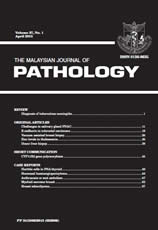Background/Aims: Differential diagnosis between aggressive osteoblastoma and low grade
osteosarcoma may be very diffi cult or even impossible on a small biopsy. This study was designed
to assess the usefulness of immunoexpression of COX-2 and osteocalcin in the differential diagnosis
of the two tumour types. Methods: Immunostaining of COX 2 and osteocalcin were studied in 9
osteoblastomas and 30 osteosarcomas. Results: All osteoblastomas and 11/20 (55%) high-grade
osteosarcomas showed COX-2 immunoreactivity. All low grade osteosarcomas were COX-2 negative.
COX-2 was signifi cantly higher (p<0.002) in osteoblastomas 9/9 (100%) than in osteosarcomas 13/30
(43%) and in aggressive osteoblastomas versus low grade osteosarcomas (p<0.01). Osteocalcin was
found in tumour cells of all osteosarcomas and osteoblastomas and in the osteoid matrix of 84% of
osteosarcomas and 78% of osteoblastomas. Strong osteocalcin was signifi cantly higher (p<0.02) in
osteoblastomas (78%) than in osteosarcomas (27%). Conclusion: COX-2 is a valuable marker in
distinction between osteosarcoma and osteoblastoma. Negative COX-2 could confi rm the diagnosis
of low grade osteosarcoma versus aggressive osteoblastoma. Intensity and distribution of osteocalcin
may indicate the degree of osteoblastic differentiation.


